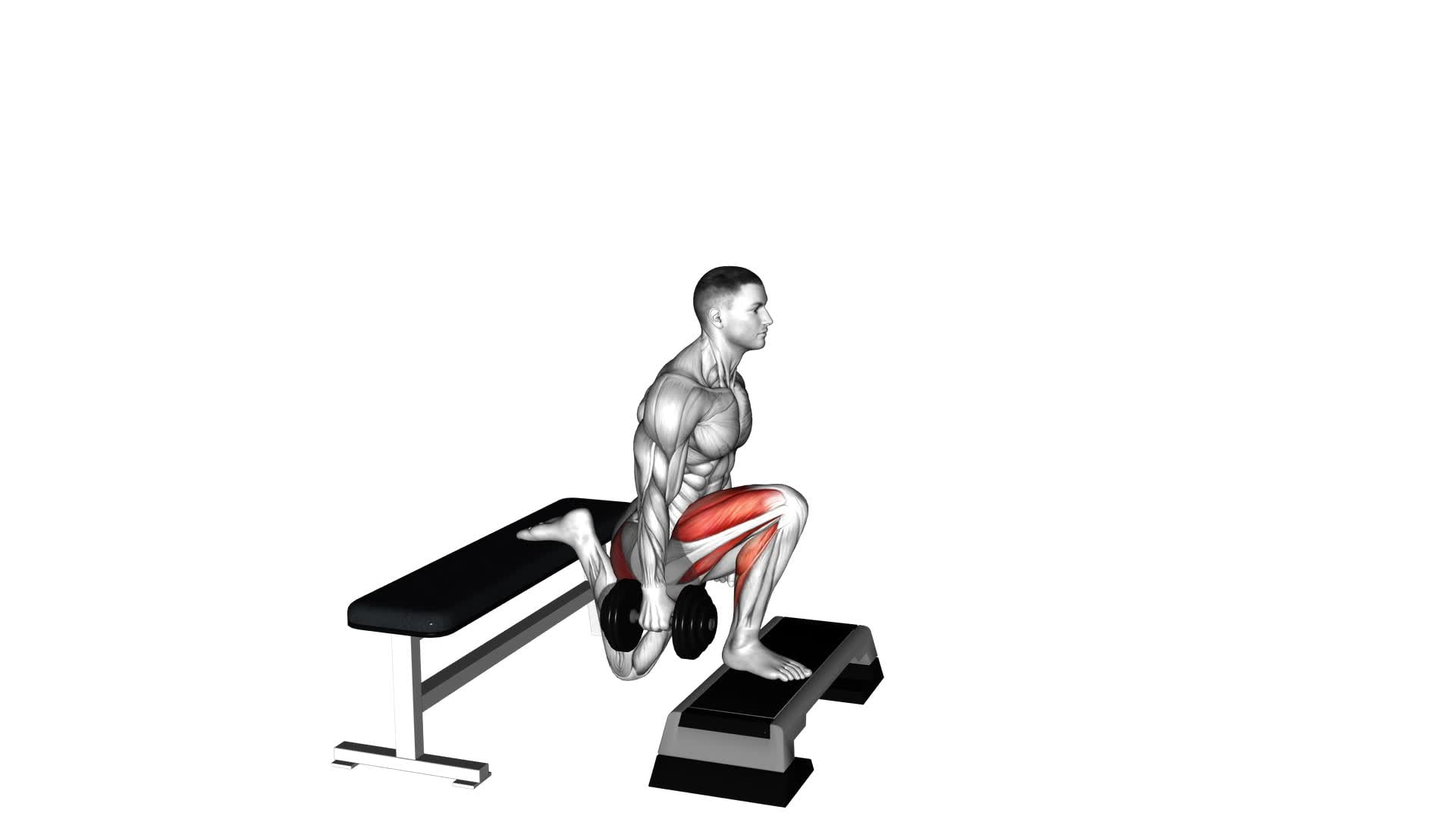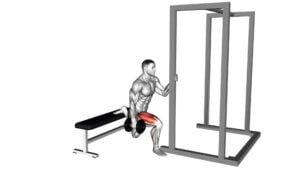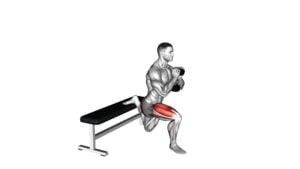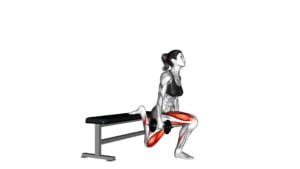Dumbbell Bulgarian Split Squat From Deficit (Male) – Video Exercise Guide & Tips

Are you looking to level up your leg workout? Then the Dumbbell Bulgarian Split Squat From Deficit is for you!
Watch This Exercise Video
This exercise targets your quads, glutes, and hamstrings all at once, helping you build strength and stability.
In this video exercise guide, we'll walk you through the proper form and setup, show you how to choose the right dumbbells, and provide step-by-step execution tips.
Get ready to take your leg training to the next level!
Key Takeaways
- Targets quads, glutes, and hamstrings simultaneously
- Builds lower body strength and stability
- Improves balance and coordination
- Enhances flexibility
Proper Form and Setup
To perform the Dumbbell Bulgarian Split Squat from Deficit (Male) with proper form and setup, you'll need a set of dumbbells and an elevated surface such as a step or platform. This exercise is highly effective in targeting your quads, glutes, and hamstrings, helping to build lower body strength and stability.
To begin, stand facing away from the elevated surface with your feet hip-width apart. Hold a dumbbell in each hand, palms facing your body. Place the top of your back foot on the elevated surface, ensuring that your front foot is positioned far enough forward to maintain balance.
As you lower your body down, bend your front knee to about a 90-degree angle, ensuring that your knee tracks in line with your toes. Keep your back straight and your chest lifted throughout the movement.
Push through your front foot to return to the starting position, engaging your glutes and quads. Repeat for the desired number of repetitions on one leg before switching to the other leg.
Choosing the Right Dumbbells
When choosing the right dumbbells for the Dumbbell Bulgarian Split Squat from Deficit (Male), it's important to consider your current strength and fitness level. The weight of the dumbbells should challenge you, but not be too heavy that it compromises your form. Start with a weight that you can comfortably perform 8-12 repetitions with, while still feeling the burn in your muscles.
If you find that the exercise is too easy, you can gradually increase the weight by using heavier dumbbells. On the other hand, if the exercise feels too difficult or you struggle to maintain proper form, you can decrease the weight or use alternatives to dumbbells such as resistance bands or kettlebells.
It's crucial to remember that proper form and technique are more important than the amount of weight you're lifting. By choosing the appropriate dumbbell weight, you can maximize the effectiveness of the exercise and minimize the risk of injury.
Now that you know how to choose the right dumbbells, let's move on to the step-by-step execution of the Dumbbell Bulgarian Split Squat from Deficit (Male).
Step-by-Step Execution
Now that you have chosen the appropriate dumbbell weight, let's dive into the step-by-step execution of the Dumbbell Bulgarian Split Squat from Deficit (Male). This exercise is highly effective for building lower body strength, stability, and balance. Here's how to perform it correctly:
- Begin by standing in front of a bench or step, with your back facing it. Hold a dumbbell in each hand, with your arms by your sides.
- Place the top of your left foot on the bench or step, keeping your right foot planted firmly on the ground in front of you. Your feet should be hip-width apart.
- Engage your core and maintain an upright posture throughout the exercise. This will help stabilize your body and prevent any strain on your lower back.
- Slowly lower your body towards the ground by bending your right knee, while keeping your left leg elevated. Aim to lower your right thigh parallel to the ground, or as close as possible.
- Push through your right heel to return to the starting position. Repeat the movement for the desired number of repetitions, then switch sides.
By performing Bulgarian split squats, you can target your quadriceps, hamstrings, glutes, and calves. Additionally, this exercise helps improve balance and stability.
For those with different fitness levels, variations can be made by adjusting the height of the step or bench, or by increasing or decreasing the dumbbell weight used. Always consult with a fitness professional if you're unsure about the appropriate modifications for your fitness level.
Common Mistakes to Avoid
Avoiding common mistakes is essential for maximizing the effectiveness of the Dumbbell Bulgarian Split Squat from Deficit (Male). To ensure you're performing this exercise correctly, here are some common mistakes you should avoid:
- Incorrect form: One of the most common mistakes isn't maintaining proper form throughout the exercise. Make sure to keep your back straight, chest up, and knees aligned with your toes. This will help prevent injuries and target the correct muscles.
- Using too much weight: Using excessive weight can compromise your form and increase the risk of injury. Start with lighter weights and gradually increase as you become more comfortable and confident with the exercise.
- Lack of balance: Maintaining balance during the Bulgarian split squat is crucial. Avoid leaning too far forward or backward, as this can put unnecessary strain on your knees and lower back. Engage your core and focus on keeping your body centered and stable.
By avoiding these common mistakes, you can reap the 5 key benefits of Bulgarian split squats, which include:
- Improving lower body strength
- Increasing stability and balance
- Targeting multiple muscle groups
- Enhancing flexibility
- Boosting overall athletic performance
If you're a beginner, you can modify the exercise by using a bench or step to decrease the depth of the squat and provide additional support.
Tips for Increasing Difficulty
To increase the difficulty of the Dumbbell Bulgarian Split Squat from Deficit (Male), add additional weight increments to challenge your muscles further. Progression options and advanced variations can help you take your workout to the next level.
One way to increase the difficulty is by using heavier dumbbells. Start by gradually increasing the weight in small increments, ensuring that you can maintain proper form and control throughout the exercise. As you get stronger, you can continue to add more weight to keep challenging your muscles.
Another progression option is to perform the split squat on an even greater deficit. This means elevating your back foot on a higher platform, such as a step or a bench. By increasing the height of the deficit, you'll engage your muscles even more, particularly your glutes and hamstrings.
Additionally, you can incorporate advanced variations to intensify the exercise. For example, you can try performing the split squat with a pause at the bottom of the movement, or you can explode upwards with more power during the concentric phase. These variations will increase the demand on your muscles, leading to greater strength and muscle development.
Frequently Asked Questions
How Many Sets and Reps Should I Do for the Dumbbell Bulgarian Split Squat From Deficit Exercise?
To progress in the dumbbell Bulgarian split squat from deficit exercise, you should start with 3 sets of 8-10 reps. As you get stronger, gradually increase the weight and decrease the reps to 6-8.
Keep proper form and avoid common mistakes like leaning forward or letting your knee cave in. This exercise is great for building leg strength and stability.
Remember to always consult with a professional before starting any new exercise program.
Can I Perform This Exercise Without a Deficit?
Yes, you can perform the dumbbell Bulgarian split squat without a deficit. However, using a deficit has its benefits. It adds an extra challenge to the exercise by increasing the range of motion and placing more emphasis on the working leg.
If you don't have a deficit, you can still do the exercise by simply performing it on a flat surface. Alternatively, you can try other exercises like lunges or step-ups to target similar muscle groups.
Is It Necessary to Use Dumbbells for This Exercise, or Can I Use Other Types of Weights?
Using dumbbells for Bulgarian split squats has its benefits. They add resistance, helping to build strength and muscle in your lower body. Dumbbells also provide stability and balance during the exercise.
However, if you don't have access to dumbbells, there are alternatives you can use. You can try using kettlebells, barbells, or even just your bodyweight. These options can still provide a challenging workout and help you achieve your fitness goals.
How Often Should I Include the Dumbbell Bulgarian Split Squat From Deficit Exercise in My Workout Routine?
Including the dumbbell Bulgarian split squat from deficit in your workout routine will depend on your goals and overall program. It's generally recommended to include this exercise 1-2 times per week for optimal results.
However, it's important to listen to your body and adjust the frequency accordingly.
Additionally, you can modify and vary the exercise by changing the weights, using different types of weights, or focusing on specific muscle groups for targeted training.
Can I Modify This Exercise to Target Specific Muscle Groups More Effectively?
To target specific muscle groups more effectively, you can make modifications to the Dumbbell Bulgarian Split Squat From Deficit exercise. By adjusting your foot placement, you can emphasize different muscles such as the glutes, quads, or hamstrings.
Additionally, you can try using alternative weight options, like kettlebells or resistance bands, to add variety and challenge to the exercise.
These modifications allow you to customize the workout and focus on the muscle groups you want to strengthen.
Conclusion
In conclusion, the dumbbell Bulgarian split squat from a deficit is a challenging exercise that targets the lower body muscles.
By following the proper form and setup, choosing the right dumbbells, and executing the steps correctly, you can maximize the effectiveness of this exercise.
Remember to avoid common mistakes and consider tips for increasing the difficulty as you progress.
Incorporating this exercise into your routine can help you build strength and improve your overall fitness.

Author
Years ago, the spark of my life’s passion ignited in my mind the moment I stepped into the local gym for the first time. The inaugural bead of perspiration, the initial endeavor, the very first surge of endorphins, and a sense of pride that washed over me post-workout marked the beginning of my deep-seated interest in strength sports, fitness, and sports nutrition. This very curiosity blossomed rapidly into a profound fascination, propelling me to earn a Master’s degree in Physical Education from the Academy of Physical Education in Krakow, followed by a Sports Manager diploma from the Jagiellonian University. My journey of growth led me to gain more specialized qualifications, such as being a certified personal trainer with a focus on sports dietetics, a lifeguard, and an instructor for wellness and corrective gymnastics. Theoretical knowledge paired seamlessly with practical experience, reinforcing my belief that the transformation of individuals under my guidance was also a reflection of my personal growth. This belief holds true even today. Each day, I strive to push the boundaries and explore new realms. These realms gently elevate me to greater heights. The unique combination of passion for my field and the continuous quest for growth fuels my drive to break new ground.







